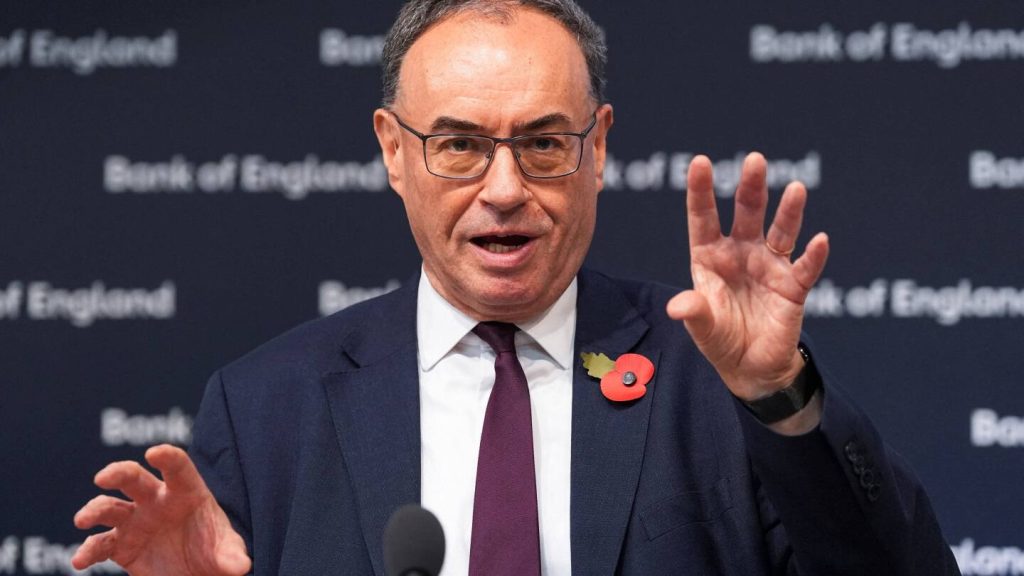Listen to the article
The Bank of England held its main interest rate at 4% on Thursday, revealing significant division among policymakers as they weigh inflation concerns against economic growth pressures. The decision came after a remarkably close 5-4 vote, with Governor Andrew Bailey casting the decisive vote to maintain current rates.
“We still think rates are on a gradual path downwards, but we need to be sure that inflation is on track to return to our 2% target before we cut them again,” Bailey stated following the announcement.
The decision breaks the bank’s recent quarterly pattern of rate cuts that began in August 2024, when it first started unwinding higher interest rates implemented after Russia’s invasion of Ukraine triggered an inflation spike. Market observers had widely anticipated the hold, though some economists had predicted another quarter-point reduction to 3.75%.
The primary factor driving the conservative approach is the UK’s stubbornly high inflation rate, which currently stands at 3.8% – nearly double the bank’s 2% target and the highest among G7 nations. This presents a challenging economic picture for policymakers attempting to balance inflation control with supporting economic growth.
In the minutes published alongside the decision, the Monetary Policy Committee noted that inflation has likely “peaked” at a lower level than their previous August forecast of 4%. This assessment suggests the committee sees some improvement in the inflation outlook, though not enough to justify immediate further easing.
The Bank of England’s cautious stance mirrors similar approaches by other central banks, including the U.S. Federal Reserve, which recently implemented its second interest rate cut of the year after a similarly tight vote. This global pattern reflects the delicate balancing act central banks face as they navigate post-pandemic economic conditions.
Financial markets are now looking ahead to the bank’s December meeting, with many analysts suggesting another rate cut could be forthcoming if inflation data shows continued improvement. “Today’s decision clearly opens the door to a December cut, but that remains contingent on the incoming data,” said Matt Swannell, chief economic advisor to the EY ITEM Club.
A critical factor in the bank’s December decision will be the UK government’s budget, scheduled for November 26. Treasury chief Rachel Reeves has signaled this will be a landmark fiscal announcement as she works to address public finance deficits. Reeves has warned that tax increases are likely, which could dampen economic activity and potentially ease inflationary pressures.
“At the budget later this month I will take the fair choices that are necessary to build the strong foundations for our economy so we can continue to cut waiting lists, cut the national debt and cut the cost of living,” Reeves commented following the bank’s announcement.
The interplay between fiscal and monetary policy will be crucial in the coming months. Higher taxes could slow consumer spending and economic growth, potentially allowing the Bank of England more room to cut rates without risking inflation. Conversely, if inflation remains elevated despite fiscal tightening, the bank might maintain its cautious stance longer than markets currently expect.
For UK consumers and businesses, the decision means that borrowing costs will remain at current levels for at least another month. The Bank Rate serves as a benchmark for mortgages and various consumer and business loans, making its movement directly impactful on household finances and business investment decisions.
The split vote highlights the genuine uncertainty within the Bank of England about the best path forward, reflecting broader economic complexities as the UK continues to navigate post-pandemic recovery, Brexit adjustments, and global economic headwinds.
Fact Checker
Verify the accuracy of this article using The Disinformation Commission analysis and real-time sources.




9 Comments
Interesting to see the BoE taking a cautious approach here, despite hopes that inflation may have peaked. Maintaining rates at 4% suggests they want to be sure the inflation outlook has stabilized before easing policy further.
The BoE’s decision to hold rates steady is understandable given the economic uncertainties. Curious to see if the bank will need to maintain a relatively hawkish stance in the coming months to rein in inflation.
Agreed. The path forward for the BoE will likely depend heavily on how inflation and economic growth trends evolve in the UK over the next few quarters.
While some may have hoped for a rate cut, the BoE’s cautious approach seems prudent. Maintaining stability and control over inflation should be the priority, even if it means holding rates steady for now.
It’s understandable that the BoE wants to be sure inflation is firmly on a downward path before easing policy further. Maintaining credibility on their 2% target is crucial, even if it means holding rates steady for now.
The BoE’s split decision reflects the challenging tradeoffs policymakers are facing. Curious to see if the bank will need to take a more aggressive stance if inflation proves stubbornly high in the months ahead.
That’s a good point. The BoE will likely need to closely monitor economic data and be prepared to adjust policy if necessary to bring inflation back under control.
At nearly double the BoE’s 2% target, the UK’s stubbornly high inflation rate is clearly the primary concern. Prudent to hold off on rate cuts until they’re confident inflation is firmly on a downward trajectory.
The 5-4 vote split highlights the divergent views within the BoE on the right policy path. Balancing inflation control and economic growth must be a delicate act for policymakers right now.